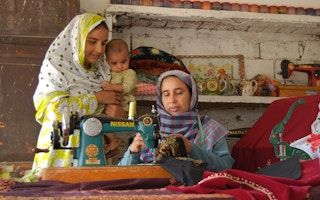In the battle to reduce greenhouse-gas emissions and avert the worst impacts of climate change, the world has a vast resource that remains largely untapped: women.
Preventing the catastrophic effects of climate change requires understanding what – and who – drives transformation on the ground. Investing in women, which means improving their access to education, economic inputs, and capital, gives governments a fighting chance of meeting their ambitious climate goals.
Several studies have shown how advancing gender equality can spur climate action. States with larger proportions of women in their legislatures are more likely to approve environmental agreements and treaties. And when more women are involved in group decisions about land management, the group conserves more. Moreover, it is estimated that boosting the productivity of women smallholder farmers could reduce carbon emissions by up to two billion tons by 2050.
The transition to clean power requires a transition in power. Or, put another way, changing power systems requires changing systems of power. Despite being responsible for half of the world’s food production, women own less than 20 per cent of the world’s agricultural land. And although women comprise 45 per cent of the agricultural workforce across developing countries (and 37 per cent worldwide), they receive only 7 per cent of investment in the sector. If they received the same access to productive resources as men, women in developing countries could increase yields on their farms by 20-30 per cent and lift 100-150 million people out of hunger.
As matters stand, women and girls disproportionately bear the brunt of the effects of climate change. According to the United Nations, women comprise 80 per cent of those displaced by climate change and are 14 times more likely to die in a climate-related disaster than men are. And by 2025, climate change could prevent at least 12.5 million girls from completing their education each year.
As the Malala Fund has noted, “following climate shocks, stressed families often pull girls out of school to help with an increase in household responsibilities – such as fetching water and firewood – or to enter early marriage to ease the burden of scarce household resources.” In Botswana, an estimated 70 per cent of children who dropped out of school during drought were girls, while in Ethiopia, child marriage increased by 119 per cent, on average, in regions suffering the most from drought.
“
To realize this vision, those in positions of power must seize this moment of peril and possibility to ensure that women and girls can fulfill their potential and, in doing so, support the shared fight against climate change and its effects.
When extreme weather events rob family breadwinners of their livelihoods and their homes, they can no longer afford to have children studying instead of working; sometimes, girls as young as 11 or 12 become brides. That means squandered talent and lost potential, as well as early motherhood for many. Moreover, children with less education are less fluent in sustainable agriculture practices.
The good news is that investing in women and girls promises high returns in terms of fostering growth, building resilience, and strengthening adaptation efforts. But taking advantage of this opportunity requires a shift in imagination and a concerted effort to make women more visible – especially in policymaking settings. At the United Nations Climate Change Conference in Egypt (COP27), women made up less than 34 per cent of country teams. In 2020, women led only 15 per cent of environmental ministries in 193 countries.
Deploying capital to support women in agriculture, keep girls in school, fund women entrepreneurs, and support women-led emergency-information networks has long been recognised as essential to achieve the goal of inclusive economic growth. But it will also contribute to reducing greenhouse-gas emissions and keeping global warming within the 1.5° Celsius limit set by the Paris climate agreement.
Imagine a world in which women farmers have equal access to inputs, women have the funds to become clean-energy entrepreneurs, girls learn the skills required to take advantage of new green jobs, and women-led networks, such as Women Wetem Weta in Vanuatu, provide early disaster warnings to safeguard their communities. This is a world of “more for more”: more children are educated, more societies can sustain themselves, and everyone can enjoy greater prosperity, security, and stability.
To realise this vision, those in positions of power must seize this moment of peril and possibility to ensure that women and girls can fulfil their potential and, in doing so, support the shared fight against climate change and its effects. The energy transition is an opportunity for us all. Making the most of it will require investing in those who will drive it forward.
Gayle Tzemach Lemmon is Adjunct Senior Fellow for Women and Foreign Policy at the Council on Foreign Relations.
Copyright: Project Syndicate, 2023.www.project-syndicate.org











